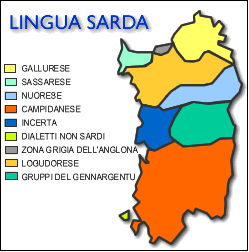
Sardinian language
The Sardinian language, or “Sardo”, is a genuine language (officially recognised by a regional law in 1997 and then on a national level in 1999), even though it is fragmented into numerous dialects, which differ from zone to zone and often even from one town to he next. However, there are four main varieties which have been recognised by linguists: Campidanese, Logudorese, Sassarese and Gallurese.
Among the idioms of Latin origin, the Sardinian language is the one which best preserves traits and words from the mother tongue. However, it also reveals many other influences, including Arabic, Phoenician, Pisan, Catalan and Ligurian, which bear witness to the island’s rich history and the numerous rules that Sardinia has been subjected to. Thus, Alghero, a characteristic town on the north west coast of the island and situated in front of Barcellona, just 300 miles away, is, in actual fact, more correctly called Alguer. The town was given its name in 1354, when it was conquered by Pietro IV of Aragon, and traces of this Catalan influence are revealed in the local dialect and the names of its monuments (the tower of San Juan, the Mirador bastion, Palazzo de Ferrera).
Similarly, today visitors to the island of S. Pietro will still see traces of the colonisation by the “Tabarkini”, people of Ligurian origin who settled there at the beginning of the eighteenth century. In fact, the dialect spoken on the island is Genoese and the local cuisine offers delicious specialities, which are curious combinations with various origins, such as the “farinata di ceci”, a dish based on chickpeas which is typical of Genoa and Savona, and “cashcà”, which derives from the Tunisian cous-cous. Today there is a strong movement to defend and promote the local language, “sa limba”, and this has led to the diffusion of a cultural bilingualism in the literary sphere, at university, and in public bodies. At the same time, this drive has contributed to projecting the knowledge of Sardo even outside the island’s boundaries. Thus, although the Holy Bible has only recently been translated into Sardo (“Sa Bibbia Sacra” – official edition of the Italian Episcopal Conference), since 1994 there has been a Nugoresu-Giapponesu-Italianu dictionary, compiled by Shigeaki Sugeta, who also teaches Sardo to students of Romance languages at the Waseda University in Tokyo.Since 1979 the Japanese professor has been travelling around Sardinia interviewing farmers, shepherds and country folk and has gathered and translated 1500 words from the dialect spoken in the province of Nuoro, the least contaminated of the Sardinian languages.

 English (UK)
English (UK)  Italiano
Italiano 